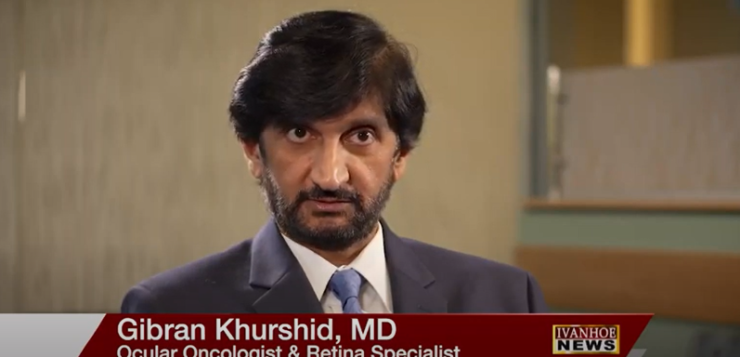Doctor Syed Gibran Khurshid, an associate professor in the Department of Ophthalmology University of Florida, talks about treating eye cancer with 24-karat gold.
Interview conducted by Ivanhoe Broadcast News in November 2021.
Are all eye cancers melanoma?
DR KHURSHID: No.
And is this only for melanoma?
DR KHURSHID: This is only for melanoma. Yes.
How many times do you see melanoma in the eye? Is it becoming more and more?
DR KHURSHID: The textbook incidence is about 4.3-5.1 people per million, which means almost seven to eight thousand cases all over the world. But my observation is in recent years, I think maybe due to environmental or dietary factors, I am seeing higher incidence as compared to my years of training and fellowship even though I don’t have a scientific proof yet. Eyes have different kinds of cancers, but most common is the uveal melanoma. And the rest are pretty rare.
Are they always caused by the sun?
DR KHURSHID: There are multiple factors; fair skin, blue/green irises, age, and UV exposure. Though it shares the same name with skin melanomas, but it is entirely a different tumor in its behavior and what it does.
How would you have traditionally treated melanoma of the eye?
DR KHURSHID: If you go back in history about quarter of a century, the mainstay of treatment was to remove the eye no matter what the vision is, where the cancer is. And then things started getting evolved, science progressed and the radiation was utilized in treating the melanomas. One peculiar thing about melanoma is no matter what you do with the eye, either remove it or save it or just treat locally, it doesn’t affect the survival of the patient. Since that fact, the whole focus of treatment was shifted towards saving the eye. There are some patients who will have melanoma in their only one eye. And taking that only eye of the patient out and leaving them blind for the rest of their life was not something we want to do. In UF we have established a complete set of modalities we can treat different kind of melanomas… small, medium, large eye cancers. It could be anywhere from laser to radiation therapy and radioactive plaque is an option. And we also have a facility which is actually one of few in the United States, I think, proton beam radiotherapy, which is an alternative form of radiation. And UF have has a center in Jacksonville, FL.
Why would these seeds even be better than something like the proton therapy?
DR KHURSHID: Not one size fits all in medicine, because the location, size of the tumor, social circumstances varies from person-to-person. These are the main determining factors to plan the radiation treatment. Plus, for example, if you want to do protons beam radiotherapy, I have to take the patient to surgery here, which comprises marking the tumor with tantalum in the eye, then wait for a month for healing, then patient goes to Jacksonville for one whole day, to have the simulation done for proton therapy and then they have to go back there five consecutive days to get the treatment done. The socioeconomic circumstances, family support sometimes is not that much where some patients were opting just to have the eye removed, even though we told them that it can be saved because they could not travel. So that’s one of the reasons. The second reason is it’s a radioactive active plaque treatment. It’s like a quarter diam and it’s very focused.
Let’s talk about the radioactive plaques. How do they work?
DR KHURSHID: So, the first step is to determine the precise measurements of the tumor, how big it is, where it is. That we usually achieve with the high-definition ultrasound images in the clinic. And then we get radiation oncologist and physicist on board. They have algorithms and calculation softwares. The radioactive plaque is ordered through an outside source. Plaque come as a gold shell. Gold is used because it doesn’t allow the radiation to scatter, so that makes it more precise.
Does it kind of look like a gold contact lens? Is that what I was reading?
DR KHURSHID: Literally it is a 24-karat gold. So, depending on how big the tumor is, how much radiation is needed to treat the tumor safely, radioactive iodine-125 seeds are embedded in the gel matrix within the gold shell, so now you have a plaque which is emitting radiation.
And you know exactly where to put those seeds because of the ultrasound?
DR KHURSHID: Yes. Ultrasound measurements are vital and there is another technique called trans-illumination that when you shine the high-powered light source in one side, it glows the red color on the other side of the eye. Any tumor blocking the red glow will appear as dark shadow. So, the tumor actually creates a dark shadow on red background of glow, and we can see it. But instead of just going directly for the live radioactive source, we have our plaque dummies, which are plaques but no radiation material in it. We put that on, stitch it, check its location with the tumor margins. When we are in precise location and ready, we remove the dummy plaque and replace it with live radioactive one. It gives a calculated metered dose of radiation because you don’t want too much in such a small time. Usually, it’s all distributed over the period of 96 hours. That necessitates to secure 2 operating room slots 96 hours apart. And this is not something which can be cancelled or delayed. For example, I do it on Monday morning and remove it on Friday morning. That comprises 96 hours. And then it’s just basically matter of time when delivered radiation dose kills the tumor, and we just monitor the patient with colored eye pictures and ultrasound measurements.
Do the patients go home after?
DR KHURSHID: Oh yes. After the plaque insertion they go home. Another thing we do, which is a little bit unique, is I usually close their eyelids with a stitch, which means there is no chance it’s going to fall out for any given reason or cause radiation to other people or anything. So, the eye is shut close. Following Friday, I open the eyelids, remove the plaque and then stitch everything back together. Radiation oncology sends it back to the supplier. Radiation safety clears the operating room and life goes on as usual.
How long do you know if it’s done its job?
DR KHURSHID: It’s usually evident within 612 weeks, and the success rate is almost 90-95 percent.
Which is kind of unheard of in any kind of cancer.
DR KHURSHID: Yes. It is these days, it’s a well-treatable cancer.
And of that 90 percent, do they all continue to keep their vision?
DR KHURSHID: Yes. I mean, most of them, yes. There are some delayed complications of radiation. And again, if it is very close to the back of the eye or the nerve, we are going to have a vision loss as a collateral damage. In such cases there’s no way we can save the vision but perhaps can save the eyeball.
What are some of the complications then?
DR KHURSHID: It’s a condition called radiation retinopathy. It’s a disease of blood vessels. The radiation, after all, it’s going to cause some sort of damage to the normal eye tissue because the tumor is actually surrounded by normal tissue of the eye. So, the radiation causes these abnormal blood vessels to grow, and they can leak. They can cause problems. And we can treat them.
What’s the best candidate for this? Who?
DR KHURSHID: The best candidate are small to medium-sized tumors located towards the front of the eye with a good eye vision. But good vision, tumor towards the front of the eye, and if they have any other disease which threatens the vision in the other eye for example, glaucoma, then I think it’s the best option.
Can you tell me about how you first came to meet Darla and what happened with her?
DR KHURSHID: Yes. She was referred to me by optometrist who saw a mass in her colored part of the eye. I performed the surgery to remove the tumor, basically opening the eye up, removing the tumor and sewing the eye back together. And then on the biopsy, we found out that it has invaded the deeper layer of the eye. At that time, because she was seeing 20/20 (normal vision), we decided to treat the residual disease with plaque radiotherapy. Sole purpose of plaque was to eradicate the deeper cells of the tumor. And it was done successfully, one and a half years ago. And she’s doing very well.
Is it common for this melanoma to spread throughout the body?
DR KHURSHID: With the advent of gene expression profiles, we now know there are two types of melanomas. One is which we call good melanoma (low risk), and one is called bad melanoma (high risk). The good ones usually stay in the eye and grow locally and destroy the eye if we don’t treat them. The bad ones are those which seed the body commonly liver before it is detected in the eye. It is genetic make-up of the tumor behind the scenes. And the way to find out the type of melanoma, is to perform micro-biopsy of the tumor at the time of treatment. We take the material of the tumor. We send you to a special laboratory. They do the gene profiling on the samples. And based on that, and considering the normative data we have so far, they’ll grade the tumor Class A, Class B and what genes it is carrying so we can determine the risk of spread. On those bases, we customize treatment for every patient, that evolves into two aspects. One, treating the local disease which is in the eye and then also providing our patients general oncology care for any spread of the disease in future and further treatment options. There isa continuous surveillance for the rest of their life. And we have our oncology department in UF, and they give us excellent support. So, when a patient comes in and you tell them they have cancer, it’s life changing sort of a situation, right? Another thing is these cancers are very silent. They come in with normal vision and find out, “oh, they have a cancer”. So, we have to be very empathetic and give them a sufficient emotional support, medical advice, and customized plans. In a practical scenario, a patient comes in with melanoma, treat and biopsy id performed. Biopsy says the tumor is a good one, so we counsel the patient about the low risk and negate their worries, they should have a normal span of life and lifelong yearly surveillance. But if the biopsy tell us, it’s a bad one, then we customize a very close follow up and surveillance follow up to catch the metastatic disease as early as possible.
Is it typical for most of these melanomas to be found at a normal eye doctor?
DR KHURSHID: Yes.
Or a normal routine visit?
DR KHURSHID: Yes. By the time it affects your vision, it’s too late because it has grown in size. So, it’s a silent killer. That’s what we call it.
END OF INTERVIEW
This information is intended for additional research purposes only. It is not to be used as a prescription or advice from Ivanhoe Broadcast News, Inc. or any medical professional interviewed. Ivanhoe Broadcast News, Inc. assumes no responsibility for the depth or accuracy of physician statements. Procedures or medicines apply to different people and medical factors; always consult your physician on medical matters.
If you would like more information, please contact:
Ken Garcia
Sign up for a free weekly e-mail on Medical Breakthroughs called First to Know by clicking here




